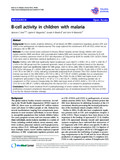| dc.description.abstract | Recent studies implicate deficiency of red blood cell (RBC) complement regulatory proteins (CR1 and CD55) in the pathogenesis of malarial anaemia. This study explored the involvement of B cell CD21, which has an analogous role to RBC CR1.In a case control study conducted in Kisumu District hospital, western Kenya, children with severe malaria anaemia (SMA) and those with uncomplicated malaria (UM) were assessed by flow cytometry for B cells (CD20+) numbers, expression levels of CD21 and deposition of C3dg and by ELISA for soluble CD21 (sCD21). Paired t tests were used to determine statistical significance at a = 0.05.Children with SMA had significantly higher lymphocyte count (9,627.7 ± 8786.1 SD vs. 5,507 ± 2436 SD,P= 0.04 in the UM group) and the computed geometric mean of mature B-cell numbers based on the absolute lymphocyte count was significantly higher for SMA group: 1,823 (1,126 to 2,982, 95% CI) and 826.6 (564 to 1,220,95% CI)] for UM group (P= 0.003). SMA group also had a higher percentage of CD20+ B cells (26.8 ± 9.7SD vs 20.9
± 9.01 SD in the UM) (P=0.03), indicating considerable polyclonal B-cell activation. The CD21 median flourescence
intensity was lower in the SMA (246.4 ± 87.4 SD vs 369 ± 137.7 SD) (P<0.0001), probably due to complement
mediated shaving of CD21 by fixed tissue macrophages. The CD20+ B cells of SMAs had higher levels of the complement split product C3dg (18.35 ± 10 SD vs 11.5 ± 6.8 S.D), (P= 0.0002), confirming possible role of complement in CD21 removal. Unexpectedly, the SMAs had lower levels of sCD21 (226.5 ± 131.5 SD vs 341.4 ±137.3 SD in the UM) (P<0.0001), indicating that the shaved CD21 is not released to peripheral circulation.These results implicate B-cell in pathophysiology of severe malaria that involves increased B-cell proliferation, increased complement deposition and subsequent loss of membrane-bound CD21. The loss of CD21 is not by the classical enzmatic cleavage. | en_US |

